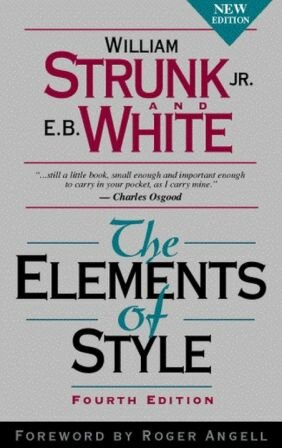
I’m sure many of you read Stanley Fish’s articles on the topic ? from a year or so ago. I came from the “great tradition” tradition, the Mortimer J. Adler mindset of reading all the great books in the Western canon. I also got my dose of composition advice, much of coming from the slightly pushy Strunk & White. Some of my professors knew Strunk & White so well that they would underline sentences and cite the pages from the revered style book that I needed to consult in order to fix my sentence. Thus I followed Strunk religiously until I read , and in recent years I have reconsidered my devotion.
First I should say that Strunk & White definitely made a difference in my writing for the better. But what has improved my writing even more has been teaching it in the last year or so. Not just teaching it to college students, but teaching it to grad school bound ESL students. Teaching ESL students made me realize that Strunk & White is aimed at native speakers, and that while ESL students could benefit from some advice in that handy little book, Strunk & White doesn’t actually help readers understand what makes prose clear and direct.
For example, I can tell a native Mandarin speaker to “avoid a loose succession of sentences,” but a Mandarin speaker doesn’t have any clue what an English speaker considers to be a “loose succession of sentences.” While I cannot speak or read Mandarin, I get the impression that almost all sentences in Mandarin would come across as a “loose succession” clauses and modifiers to an English speaker (if any Mandarin readers could enlighten me about the truth of this impression that would be fabulous). This is not a judgment on Mandarin, but a recognition that different languages consider different writing habits to be stylistically virtuous.
Take the Korean as another example. Again, I’m no expert, but from what I’ve read and been told, complex levels of cultural subtleties that would baffle the mind of most native English readers are built into the Korean language itself. Implication is always preferred; topics are spoken around. In an English essay, it is usually considered anathema to “drop in” a quote without any context or explanation. In Korean, I’m told this is preferred. You have no idea how frustrating this made me the first time I read some of the essays written by my Korean students. Thus, the wise advice of Strunk—“Use the active voice”—does not help a Korean learn how to satisfy the English desire for directness of speech and ideas. And let’s be honest, the jargon of most academics is not a good example, either.
So I switched tactics and started using Joseph William’s Style: Lessons in Clarity and Grace. Williams believes that writing becomes clear when we can see our sentences from the perspective of a reader. I’ve found that his principles have not only helped me as a writer, but also as a reader. Moreover, his style rules help non-native speakers understand what English speakers want when they read English.
Williams has even helped me get over my comma issues. When I was in second grade, I had a teacher that taught me to “use a comma wherever I paused in speech.” This was helpful enough until eleventh grade when I had a grammar Nazi English teacher who made me cower at the thought of a comma splice. My college professors continued to drill this into my brain to the point where I would use “Ctrl+F” to check every comma in my essays before I turned them in. So until recently, I have thought of comma placement as determined by relatively strict rules. Williams’ Style, however, helped me realize that…it’s actually both. Pauses, yes, and rules. That might upset some of you, but I’ve found it to be true. I could explain, but it’s probably worth another blog post.
Anyways, the point of this blog post was to ask readers a question: what is your preferred style book? Do you stick with Strunk? Do you like Eats, Shoots, & Leaves? None at all? Leave your thoughts in the comments box.
